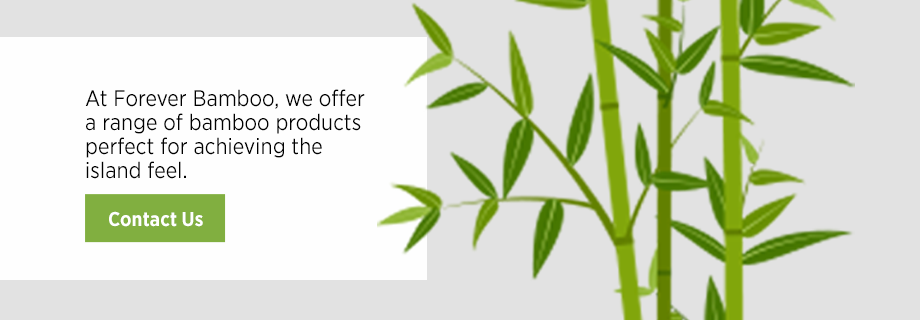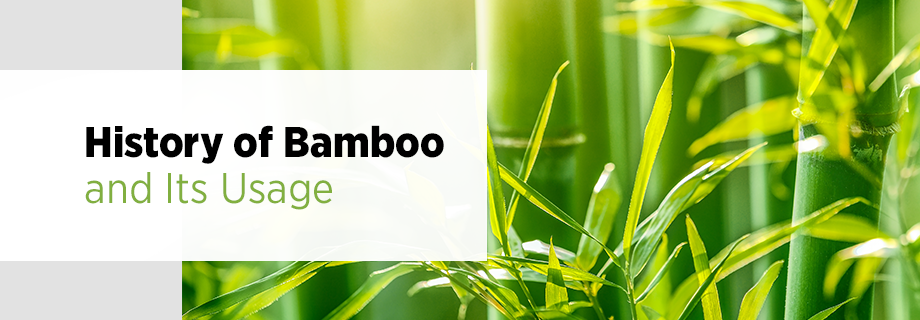
Bamboo is a beautiful building material that’s appearing in more buildings and homes. You’ll find sustainable flooring options, island-inspired furniture, rustic decorations and more when you look for bamboo products. Cultures have used bamboo for countless purposes for centuries. Some of those innovative bamboo applications inspired how we use the material today. If you’ve ever wondered how bamboo usage developed into what it is today, read on for the intriguing history of bamboo.
Jump To Sections:
- What Is Bamboo?
- Bamboo Uses Over Time
- How Is Bamboo Used in Design and Construction Today?
- Benefits of Bamboo
What Is Bamboo?
When you picture bamboo, you may imagine green shoots next to hungry pandas. Maybe you picture a beautiful garden or Zen landscape with walls made of living, growing bamboo. While those are common appearances for the plant, there’s a lot you may not know.
Despite its primary use as wood in building projects, bamboo is a member of the grass family. Being a variety of grass contributes to its ability to regrow and do so quickly. Bamboo can grow much taller and broader than the grass you’d see in the average lawn, though.
There are a wide variety of bamboo species out there — over 1,400, to give you an idea of the array available. Some only grow as high as four to six inches, while the largest can get up to 130 feet tall. No matter the final height, a stalk of bamboo grows to its maximum height and width within one growing season. If left uncut after that, they will sprout other branches rather than growing taller.
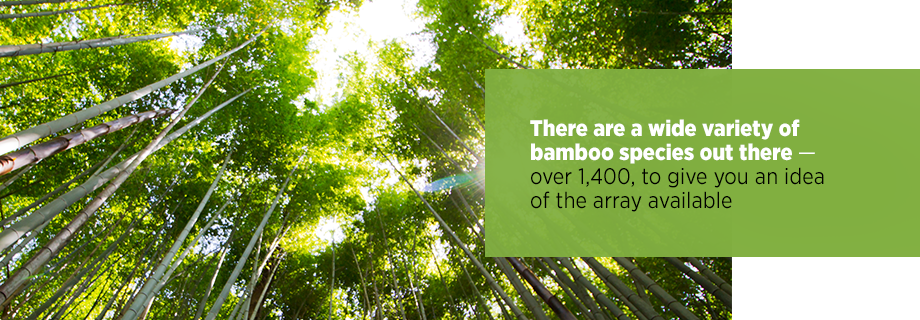
The range of species and heights makes bamboo suitable for many purposes, which is why people have been using it for centuries. People prize the material for its durability and lightweight structure. Hollow chambers create bamboo’s stems and make it lighter than wood. While the stem, or culm, of bamboo plants is the more significant part, individuals have used other sections of the plant throughout history.
Bamboo produces leaves, which help the plants collect energy. Cultures have harvested the leaves to feed livestock, and they’ve been part of pandas’ diets throughout time. Older bamboo does flower and produce seeds, but only once in its life. Still, many varieties of the plant can spread quickly through an underground network of rhizomes. These are stems buried under the soil that make bamboo spread excessively when not maintained. This rapid growth leads to the spread of bamboo when planted in a non-native region.
You may naturally associate the plant with its native areas throughout Southeast Asia, but it does have other homes throughout the world. While the history of bamboo often focuses on its uses in China, the plant grows in countries across the globe, such as:
- The United States
- Japan
- Parts of Australia
- India
You’ll also find bamboo in areas of Africa and South America. That makes Europe and Antarctica the only continents without native bamboo plants. The plant grows in warmer climates, giving it an association with island or tropical themes. As long as the weather is right, however, bamboo can proliferate and spread throughout an area, which can make it challenging to remove. That’s likely why it has spread throughout continents and countries. In addition to being in such a widespread area, bamboo also comes with a rich history of usage.
Bamboo Uses Over Time
Ever since its discovery, cultures have used bamboo for many applications. The fact that it’s easy to grow, harvest and transport made it a popular choice of building material. Its properties also made it an excellent crop to grow. Harvesters found bamboo appealing for a number of reasons:
- It has shallow roots: Because bamboo roots don’t require much depth, harvesters can plant them in soil that’s not ideal for other plants. Trees need more room and nutrient-rich soil for their roots. Bamboo, on the other hand, can thrive in areas where the soil gets rocky a foot or so down. That makes it easier to plant and grow because farmers don’t need to clear out rocks or other materials buried in the soil.
- It lasts a long time: A crop of bamboo can yield materials for about 50 years with proper maintenance. A harvester won’t have to replant crops continually, meaning they save money on planting and can focus on selling the material. While farmers do need to care for the plant in its first few years, bamboo is self-sufficient after that. Other crops need constant attention, and harvesters need to replant them every growing season.
- It multiplies: Some varieties of hardwood can take 100 years to grow to their maximum height. In contrast, bamboo reaches its maximum in one growing season. Harvesters can take materials from mature bamboo, knowing it will regenerate by the end of the next season. It won’t take long after planting to reach this stage, especially compared to hardwood trees.
- It helps surrounding areas: Like other plants, bamboo helps create cleaner air. It can also absorb nutrients from sources like sewage, minimizing that material’s environmental impact. In addition to purer air and soil, bamboo helps prevent flooding. During natural disasters, like monsoons, bamboo’s network of roots and stems slows the flow of water. Slowing and absorbing excess water helps prevent floods downstream.
With all these positives to growing and harvesting bamboo, it’s no wonder it became a staple of so many cultures. Along with its quality of being a low-maintenance crop, the plant is also a multitasking material.
Because bamboo is such a versatile plant, individuals have used it in a variety of ways. Some purposes of bamboo in the past include:
- Food for animals and livestock
- Medicine
- Musical instruments
- Carved artwork
- Irrigation systems
- Weapons
- Cutting boards, bamboo steamers and other kitchenware
- Clothing, bedding and other fabrics
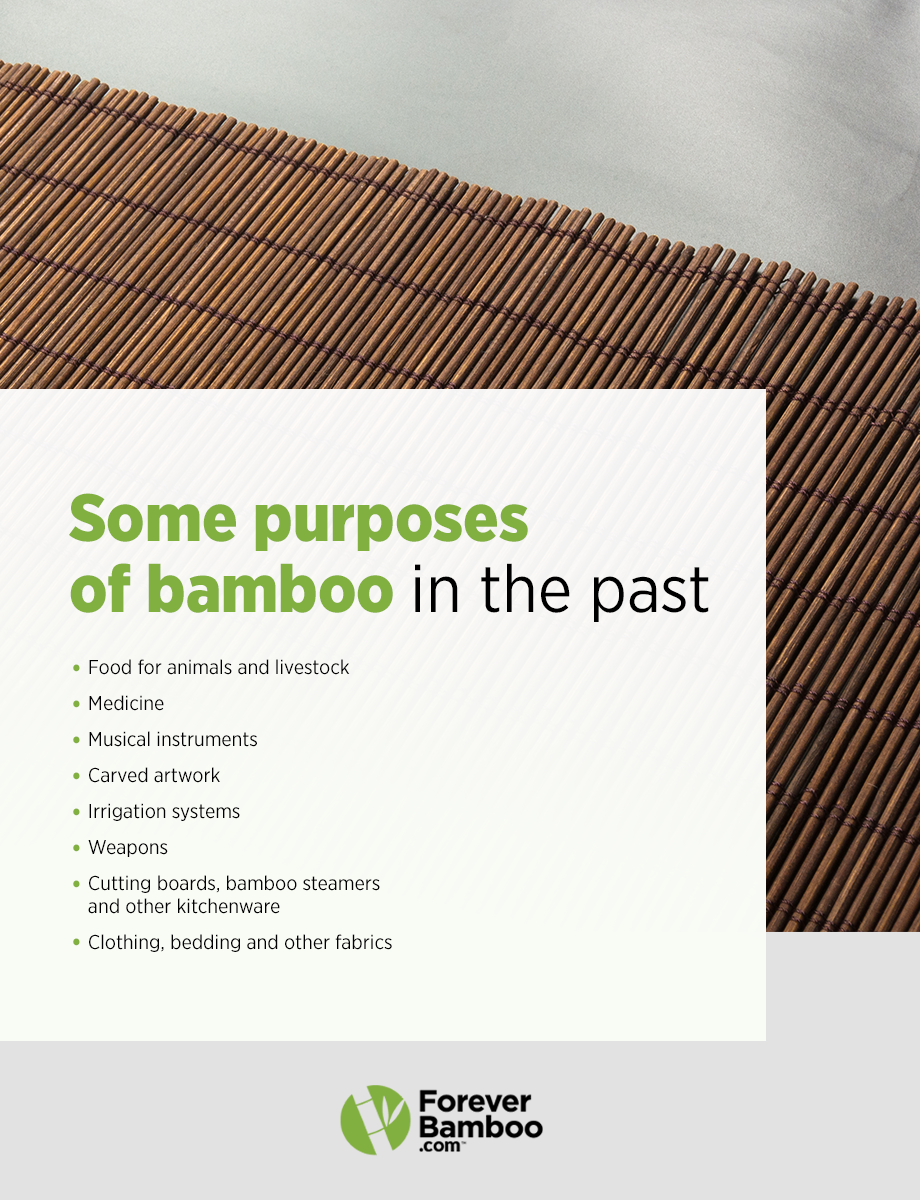
Its use throughout different fields and industries made bamboo a vital part of daily life. Along with frequent use of the plant came a bamboo culture.
Users developed a respect for bamboo and associations with positive meanings. Generally, the plant symbolizes beauty and regrowth or resistance. In addition to the use of bamboo in daily life that created this culture is its use over several millennia.
Documented appearances of bamboo date back 7,000 years, but the plant has existed even before humans came on the scene. Read on for a brief bamboo history.
- Early uses: Over 5,000 years ago, Chinese people used bamboo to construct treehouses, beginning its legacy as a sturdy building material. From around 200 BCE to 200 CE, bamboo created paper and books. With that came the classification of over 60 documented plant varieties in China between the third to fifth centuries. The more individuals discovered about this plant, the more they wanted to use it.
- Developing applications: Bamboo came inside for use as an interior building material with the Ming Dynasty starting in the 1300s. Individuals used the plant to create bedding and flooring for their homes. This use further established bamboo as a building material for indoor and outdoor use alike.
- More than furniture: Beginning in the 600s, the Tang Dynasty developed bamboo musical instruments. The material established an even stronger cultural legacy with this bamboo application. Other cultural uses of bamboo include inspiration for art, poetry and music, as well as use in cultural dishes and meals.
- Bamboo becomes hardwood: In the late 1990s, inventors in China developed a treatment that made bamboo look and feel like hardwood. By cutting and planing the bamboo stalks into planks, manufacturers created a durable alternative to hardwood flooring and boards. Before the 20th century, China and Japan used laminated bamboo for flooring.
Since its initial use, bamboo became more refined as a building material. Other historical uses of the plant include the world’s oldest water pipe, a bamboo drill and ropes made of the plant. Innovative individuals have even created transportation out of bamboo, constructing:
- Planes
- Airships
- Boats
- Rafts
- Bicycle frames
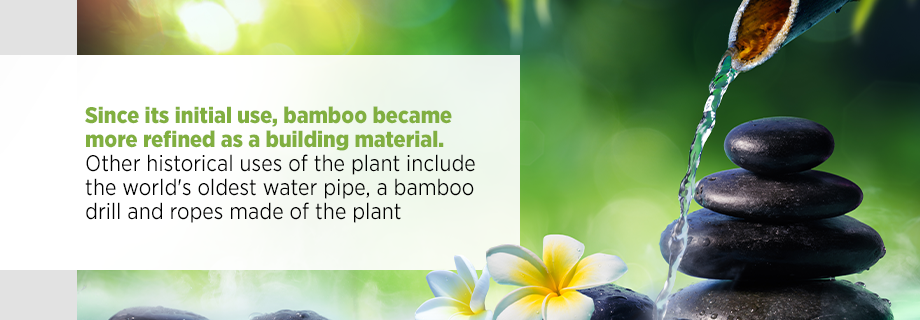
The lightweight, yet sturdy, material found its purpose in countless applications over time. When harvesters discovered how quickly the plant regrew, it made bamboo even more appealing and gave it a permanent place in the building world. People have been using this grass species for functional builds throughout time. The history of bamboo and its range of uses paved the way to developing the plant as a building material today.
How Is Bamboo Used in Design and Construction Today?
With its history, including the construction of a palace during the Han Dynasty, bamboo carries rustic and tropical associations. Many builders and designers use it today to provide an island feel to a room or building. They use the material in some surprising ways to achieve these aesthetics, some of which call back to bamboo’s history.
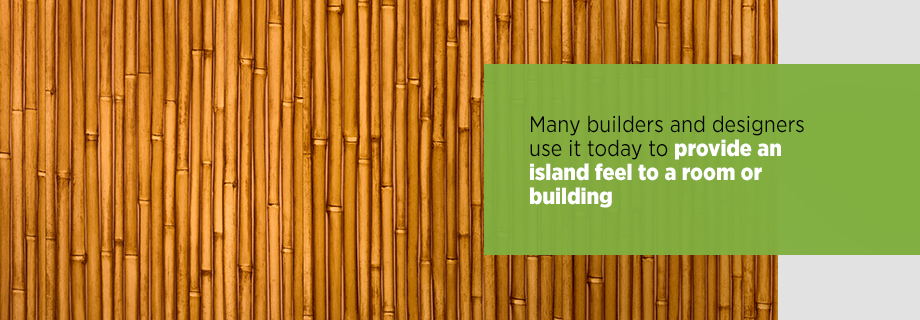
If you know about bamboo as a building material, you may only know about bamboo flooring. Bamboo has many surprising uses throughout a build. Some bamboo applications in buildings or the building process include:
- Bridges
- Construction scaffolding
- Substitute for reinforcing rods in concrete
- Pipes
- Blades for wind turbines
- Other components of renewable energy machines
Using bamboo for functional applications has its roots in history. From ladders, builders developed scaffolding. From irrigation systems, manufacturers created pipes for different purposes. Bamboo has its place throughout every stage of the construction process, just as it did in the past. While those serve structural and practical purposes, many builders use bamboo for decorative reasons. You’ll find plenty of tropical-inspired pieces, such as the following.
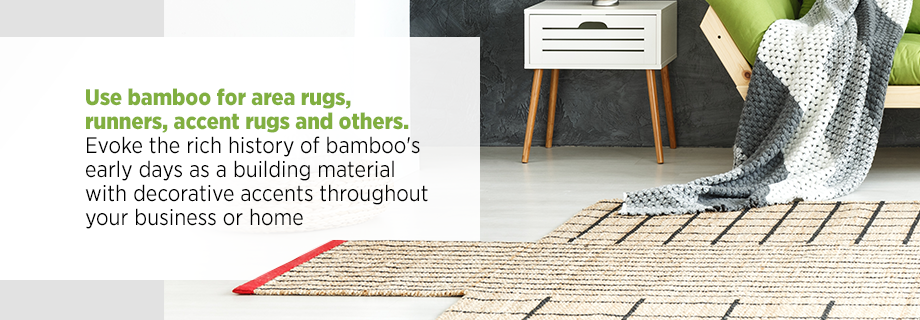
- Fencing: Bamboo fencing has uses inside and outside. Put up bamboo fences outdoors for a purposeful and stylish structure. You could also use it indoors to define a space or provide privacy when used like a half-wall. Create a tropical oasis that calls back to the past.
- Poles: Bamboo poles have helped construct all sorts of objects and furniture. You can create almost anything you imagine with this material, and it goes together in the same way wood builds do. Use nails or glue to construct whatever bamboo creations you desire for a modern twist on the historic building material. Make almost anything for your home or business with these items.
- Borders: Also called bamboo edging, these borders are great for landscaping projects. They’re much shorter than fences but still provide the rustic style of bamboo. Get the feel of an ancient garden right in your backyard or your business’ landscape by bordering off walkways, flowerbeds and more with bamboo edging.
- Paneling or slats: Add texture to your walls or ceiling with bamboo panels. While this is a more modern use of bamboo, it owes its origin to historical bamboo structures. Get the same look inside by attaching bamboo slats to your existing walls. You’ll get the benefits of modern construction with the look of the classic building material. Call back to those first bamboo treehouses with the appearance of bamboo walls and ceilings.
- Rugs: Use bamboo for area rugs, runners, accent rugs and others. Evoke the rich history of bamboo’s early days as a building material with decorative accents throughout your business or home. Bamboo rugs are sturdy and beautiful. They add interest to a space, protect your floors and define areas of a room.
- Furniture: As a versatile material, bamboo can create any furniture you can think of or need. Style meets function in pieces like bamboo shelves, storage and other furniture. From benches and chairs to tables and nightstands, bamboo furnishings give an island feel to any room because of the material’s historical association.
- Blinds: Keep out the sun in style. Choose from rustic, contemporary or other bamboo blinds to suit your space and give visitors some shade. Use them inside in traditional ways, or get creative with outdoor and other applications.
- Decorations: Shorter bamboo plants make great indoor additions to your space. Instead of standard house plants, choose small species of bamboo to add a touch of history and a tropical vibe to any room. If you’d like bamboo outside, be sure to keep it in a planter instead of planting it directly in the ground, since it can spread quickly enough to take over your yard. Remember you have bamboo fencing and other options if you’d like to bring the look outdoors without the hassle.
- Art: You could find or create bamboo sculptures and wall art, but your use of bamboo doesn’t have to be all physical. Call back to the historical art associated with bamboo by hanging artwork of the plant. It gives guests, customers and visitors a clue about what building material they’ll see throughout your space and honors traditional bamboo art.
You can create a cohesive space or business with all of the bamboo products out there. Add bamboo seating in lobbies, create feature walls in any room and use bamboo edging to define paths. No matter where you use it, you can feel good about using a sustainable material that also comes with other advantages.
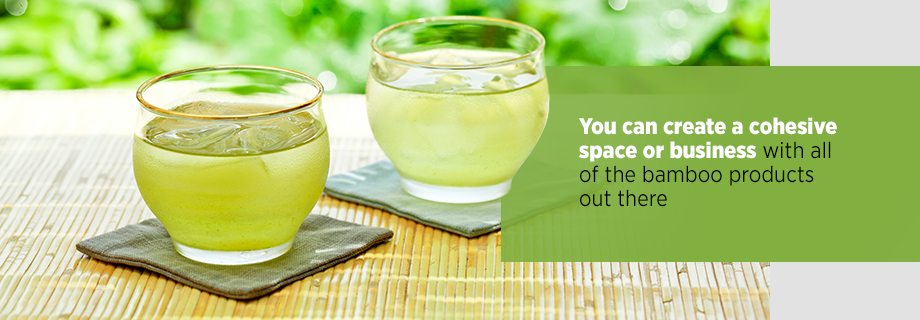
Benefits of Bamboo
Once you know some of the benefits of bamboo, you’ll understand its usage throughout history and today. As a building material, bamboo is incredibly sustainable. Younger members of the tall species can grow about three feet high in a day, and other species grow about one foot high per day. It also regrows even when cut down as long as it has enough energy supply. If leaves get the chance to photosynthesize in the sun, the network of bamboo plants will keep growing.
Because it regrows quickly, bamboo is a more efficient alternative to hardwood. Among other advantages of the material are as follows.
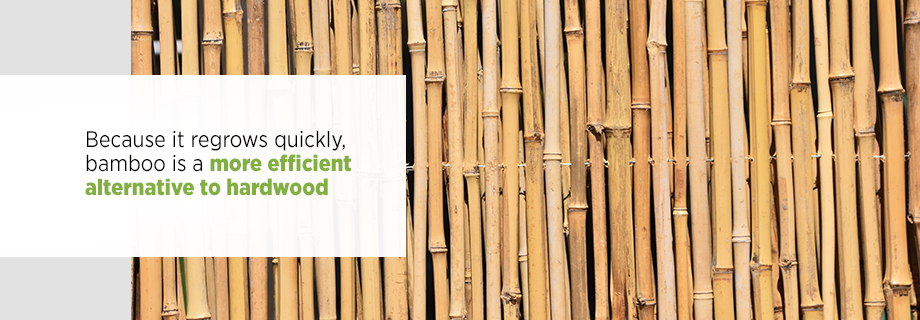
- Its flexibility: Bamboo bends without breaking. Because of its pliability, builders use it in constructions to withstand earthquakes. The material bends with external force instead of shattering and can return to its original state. Its flexibility also makes bamboo useful for curved projects, such as sculptures and handles of handbags.
- Its durability: Along with being pliable, bamboo lasts a long time. It’s less prone to warping than wood is, making it an excellent choice for humid climates. Because it won’t warp as often as wood, your bamboo products will last much longer. You can ensure the material’s durability by using bamboo stain and sealer, as well.
- Adding texture to projects: Adding bamboo to walls, ceilings, floors, furniture and more adds interest to a space. With its combination of cylindrical rods and sleek lines, bamboo can add texture to almost any surface or room. From feature walls to eye-catching furnishings, bamboo creates a stylish, yet rustic, appearance in any room.
- A versatile style: Whether you want a tropical or refined feel for your building, bamboo will provide it. Use it in different ways to create an oasis or evoke history with similar uses from the past. Choose panels or flooring with sleek lines for a modern twist on the classic material.
- A unique look: While bamboo flooring is common today, you could also use the material in unique ways. Incorporate it in panels on your walls or as fences inside and outside. Find beautifully crafted bamboo furniture that gives rooms a unique touch. Your visitors will have seen hardwood furniture before, but bamboo adds something special to a build.
- Its resistance: When treated properly, bamboo furniture and products will last for years to come. If you use the proper sealer on your bamboo builds, the material will also be water-resistant. Bamboo is also more immune to insects and disease than trees and hardwood, since it’s a type of grass.
- Efficient and sustainable energy: The plant even has advantages in uses outside of construction. Bamboo produces the same amount of energy as traditional coal, but it does so more efficiently. Bamboo creates much less ash than coal, which makes it easier to dispose of once burned. Charcoal from bamboo also emits no sulfur, which regular coal does emit. Overall, bamboo has more pros than traditional coal, from harvesting methods to how it burns.
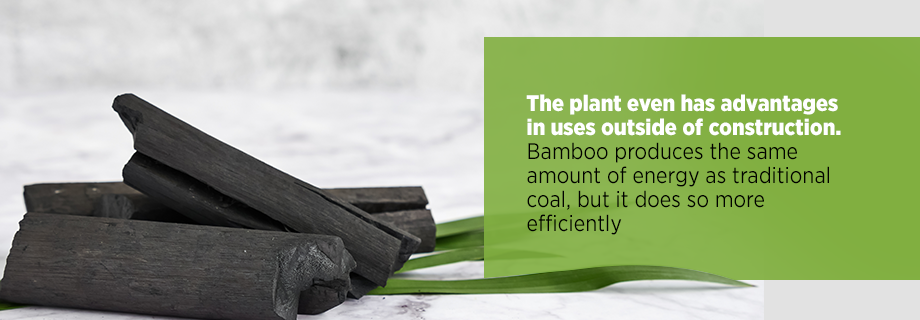
With its historical associations, a variety of products and countless advantages, bamboo is a great material to use in:
- Homes
- Resorts
- Zoos
- Restaurants
- Theme parks
- Other tropical-themed properties
Even if you aren’t going for a tropical or island theme, bamboo is versatile enough to work in any space. No matter your style, you’ll always get the bonus of creating a sustainable space. Using bamboo throughout your property can become a significant selling point. Appeal to environmentally conscious visitors by putting bamboo pieces at the front of your design. Proudly display your bamboo furniture, decor and building elements to show guests you care about using sustainable goods.
Shop Bamboo Products With Forever Bamboo
Forever Bamboo offers high-quality, eco-friendly building solutions. We have the largest inventory, offering you an array of products to get your business or home looking polished, tropical and stunning. Whether you are in the hospitality industry, have another business to decorate or want to add traditional elements to your home, we have something for you.
At Forever Bamboo, we offer a range of bamboo products perfect for achieving the island feel. Use our high-quality products to add rustic charm or contemporary interest to any space. Shop our selection of bamboo products or contact us at 877-912-2244 today. Our professional, qualified staff will answer any questions you have about bamboo applications to help you transform your business or home. Create the oasis you and your guests have always dreamed of with sustainable bamboo products!

